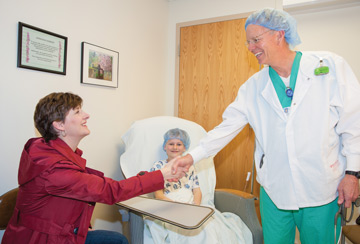April 25, 2024
Growing demand for anesthesia services at ASCs is being met with a dwindling supply of anesthesia providers....
This website uses cookies. to enhance your browsing experience, serve personalized ads or content, and analyze our traffic. By clicking “Accept & Close”, you consent to our use of cookies. Read our Privacy Policy to learn more.
By: Nicole Azzara
Published: 12/19/2019
Every patient who walks into your facility expects to undergo successful surgery and receive compassionate care. In today’s competitive, consumer-driven healthcare marketplace, that’s not always enough to translate into positive patient satisfaction scores, which can make or break your facility’s reputation.
“Patients now have the ability to research where they can go to for care,” says Leia Engle, MSN, CGRN, RN-BC, clinical manager at Memorial Hermann Northeast Hospital in Humble, Texas. “If they see that your facility has received poor reviews, they might choose to go elsewhere.” Implementing these 6 pillars of patient-centered care won’t give them that option.
Schedule cases with more predictable times early in the morning so you can better gauge patient arrival times. When you get to the longer cases later in the day? “Give patients a general idea of an arrival time, but call them and have them stay home longer if the surgeon is running behind,” says Rebecca Rainey, RN, operating room lead at the Center for Minimally Invasive Surgery in Munster, Ind. “Most patients respond well when we tell them the surgeon specifically asked that we let them know and update them.”
Use pre-op phone calls as opportunities to inform them about what to expect on the day of the procedure, answer any questions they might have about the surgical experience and reduce their anxiety before they arrive for surgery. Communicate what makes them nervous to the frontline staff so they can help make them feel at ease when they arrive for surgery.

“Evidence-based studies show that patients who trust their providers have better outcomes,” says Ms. Engle. “We find it’s probably more important that patients trust their nursing staff because we’re with them longer than surgeons are. The more we connect with them as a person, the better their experiences and the higher their opinion of the care they receive.”
Ask patients if it’s OK to address them by their first names, which helps to build a more personal connection and ensures they don’t feel like just another case you have to move through the facility. It’s impossible to avoid standing directly over prone patients, but doing so can be an intimidating presence from the patient’s point of view. Whenever possible, stoop down to their level to talk with them, hold their hands and make direct eye contact. Also pause, and refocus on the patient in front of you in the moment.
“Every nurse who comes in contact with our patients makes an effort to know them, beyond their chart,” says Ms. Engle. “We sit at the bedside and talk about their life outside the facility. We’ve discovered so many amazing things about our patients, and we have bonded with them on a different level.”
When talking with patients, ask them about seemingly little things about their personal lives — family members, recent travels and pets are popular conversation starters. You’d be surprised by how much they’ll be willing to share and how appreciative they are of your interest. “Just asking about the basics,” says Ms. Engle. “If you have a conversation with them about the dogs they have at home, it makes them more relaxed.”
Try to avoid talking about touchier subjects like religion or politics, unless patients bring them up. “One of our newer nurses actually bonded with a patient over religion,” says Ms. Engle. “The nurse even started taking her to church and doctors’ appointments. It was amazing to see such a bond develop after they spent a short time together in the recovery room.”
Conduct “leader rounding,” which is just as it sounds — a leader from the surgical department or facility personally checks in on patients to see how they’re doing. “It’s no different than when a manager at a restaurant stops by tables to see how patrons are doing,” says Dan Lantos, MSN, RN, CNML, nurse manager of radiology at Atrium Health Cabarrus in Concord, N.C. “The same concept applies to leader rounding. It shows there’s effort being put into making patients as comfortable as possible and gives the facility credibility in patients’ eyes.”
Just seeing that a leader from the department is interested in taking the time to introduce themselves and make sure everything is OK is incredibly reassuring, according to Mr. Lantos. “As leaders, supervisors and managers, we are all pressed for time every day,” he says, “but spending just a few minutes with patients can make a powerful impact.”

Mr. Lantos, who tracked the results of 465 patient satisfaction surveys collected throughout 2017 in the endoscopy department of his hospital, says survey results reflect the true feelings and opinions of your patients. “We have an online portal we use to access the surveys,” says Mr. Lantos. “We look at each question and see which ones have the lowest scores and the reasons for the low rating.”
He suggests paying attention to each response and focusing on addressing specific areas of dissatisfaction. He took the analysis one step further by analyzing satisfaction scores based on patients’ age, gender, race, procedure time, history of endoscopic procedures and whether a departmental leader had met with them during their stay. His goal was to identify patients who were statistically more likely to return a poor survey. For example, he found satisfaction scores were high at the beginning of the day and began to decrease around 11 a.m., which makes sense because patients have to remain NPO as they wait all morning for their procedures to begin.
That finding was unique to Mr. Lantos’s facility, but the lesson is universal: Scratch beneath the surface of survey responses to look for common trends, and take steps to address them.
OK, having all staff members who cared for a patient sign a card thanking them for choosing your facility is nothing new, but do you personalize the greetings or simply have staff sign a boilerplate greeting? Ms. Engle believes sending thank-you cards to a patient can provide them with a warm feeling about their experience, especially when you add personal details that make it more meaningful to them. “If a patient just became a grandparent, for example, we’ll write in the card, ‘Thank you for choosing us and congratulations on your new grandchild.’ That small gesture means a lot to patients,” says Ms. Engle, who adds that one patient was thrilled to receive the card because it was the first piece of mail she had received after surgery that wasn’t a bill.
Hold meetings with staff and providers from all areas of the facility to go over the results of satisfaction surveys and make adjustments based on the feedback, says Ms. Rainey. For example, her staff learned some patients were frustrated by receiving too many calls from the facility before their procedures. Now, they kill 2 birds with 1 stone: A member of the business office calls patients to review out-of-pocket obligations, and then transfers the patient to a pre-op nurse who reviews the clinical checklist. This simple change cut short the game of phone tag.
Share positive feedback, too. Post complimentary quotes from patients in the breakroom for staff, surgeons and anesthesia providers to see. Sharing the positive things patients say about your team will inspire them to continue delivering great care.
Ms. Engle recalls when a leadership change at her facility caused tension among the staff. Patients could sense — and in some cases see — the negative ways employees interacted with each other and noted in their satisfaction surveys that it was obvious the staff didn’t like each other. She knew things had to change and had staff focus on how they interacted with each other as much as they emphasized patient-centered care.
As the staff started to respect each other as people instead of just colleagues, patients took notice and satisfaction scores began to increase. “We also see the nurses and staff talking to the patients differently,” says Ms. Engle. “Even on the busiest days, staff never refer to patients as a number or a procedure. They’re always referred to by name and treated like a person. You can just feel the positivity of the center and see that people are happy and love to be there. That small attitude adjustment made a big difference in our patient satisfaction scores.” OSM
Growing demand for anesthesia services at ASCs is being met with a dwindling supply of anesthesia providers....
Improvements in both workflow and staff attitudes are part of a leader’s responsibilities, but your interventions in these areas don’t need to be major to make...
The ASC market continues its rapid growth. In 2023, roughly 116 new ASCs opened in the U.S., many of which were orthopedic-specific in nature....